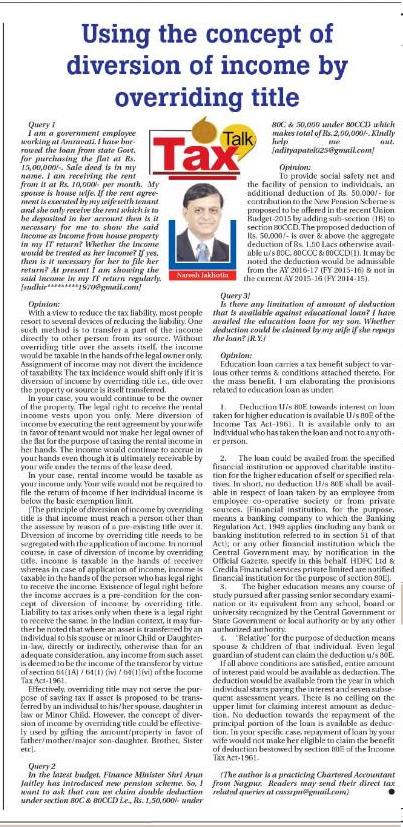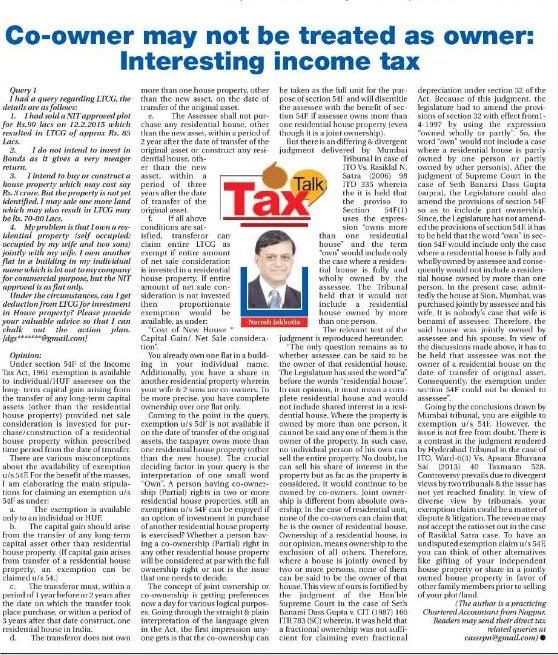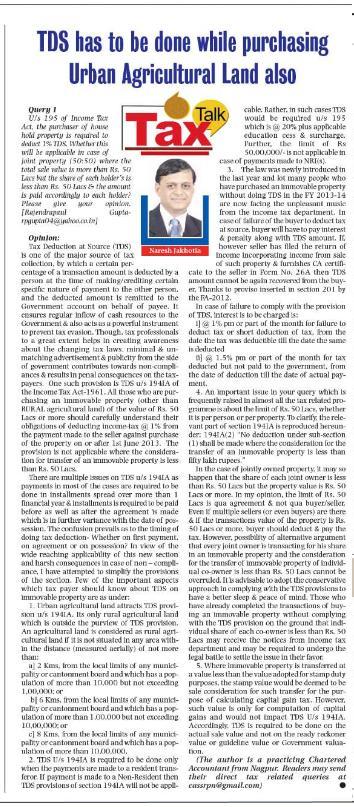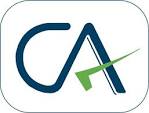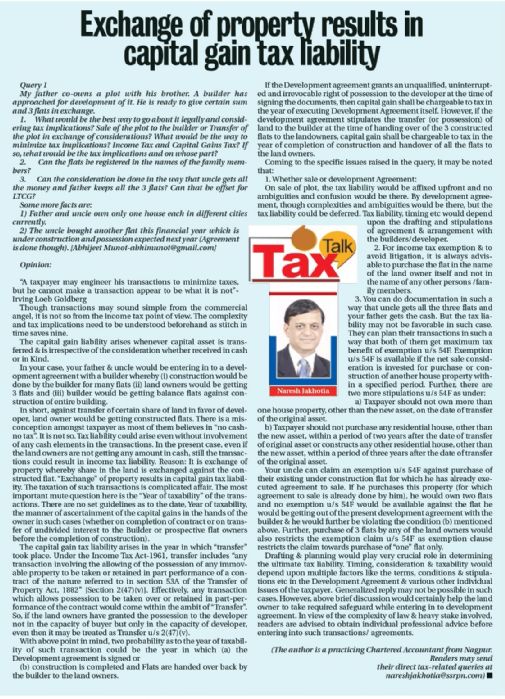Article Details
| ELSS income is totally tax free |
|
TAX TALK-19.06.2017-THE HITAVADA TAX TALK CA. NARESH JAKHOTIA Chartered AccountantEquity Linked Savings Scheme (ELSS) is the tax-saving mutual fund which offers tax benefits. ELSS income is totally tax free Query 1] I am a senior citizen doing business with my known customers (all vat dealers) on credit basis & payment by cheque. My t/o is below Rs. 60 Lakh. As per rules, I show 8% of sales as profit and that is all. Now I wish to close business due to age etc. There is huge outstanding of about 20 months sales. By follow up, I may get payments in say 2 years. My question is how I will show these receipts after closing business, so that I do not have to pay taxes again as per rules. My friends tell me that I show the outstanding in my returns which I have not done so far. [Suresh Joglekar-snjoglekar@rediffmail.com] Opinion:
Query 2]
Many of the taxpayers are still not aware of ELSS as a tax saving option. Equity Linked Savings Scheme (ELSS) is the tax-saving mutual fund which offers tax benefits also & can be started with a minimum amount of Rs 500/-. ELSS invests a majority of their portfolio in the stock market & carries a lock-in period of 3 years. Investments can be made in lump sum or through a Systematic Investment Plans (SIP) which allows investment of certain sum on a fixed monthly enabling investor to take the advantage of share market fluctuation & saving from catching a market peak. For reckoning tax benefit & lock-in period, each SIP is considered as fresh investment and every individual SIP carries a lock-in of 3 years. Unlike fixed return investment like PPF/NSC, ELSS funds don’t guarantee any fixed returns because as they are linked to equity market. ELSS funds do not allow premature redemptions before completion of the 3 year lock-in period. One can also stop an ELSS SIP at any point, but the invested amount can be withdrawn only after 3 years. ELSS funds have two plan options: growth and dividend. Under dividend option, dividend is paid on annual basis whereas in growth option, amount remains invested therein. Under the dividend option, the investor can choose between dividend payout or dividend reinvestment. Tax benefit:Investment in ELSS is eligible for deduction subject to overall maximum cap of Rs. 1.50 Lakh u/s 80C. There is no upper limit on how much you can invest in ELSS funds but tax-saving can be availed on only a maximum of Rs 1.50 Lakh a year. In case of SIP investments, redemptions can be done on a first-in-first-out basis since each individual SIP has a lock-in of 3 years.ELSS operates on EEE model i.e., investment is eligible for deduction, income on ELSS fund is totally tax free and withdrawals from ELSS is also tax exempt. To be more specific, whenever units of ELSS are sold, income (i.e., long-term capital gain) is exempt from tax. The dividend received will not be taxable. If dividend reinvestment option is chosen, it will be treated as a fresh investment and one can claim tax benefit u/s 80C on dividend reinvestment also. Income on redemption of ELSS is required to be shown in “schedule EI” in the ITR forms. Amount received on closure of PPF account is not required to be shown anywhere in the ITR forms. If you don’t have any business income, you can file income tax return in ITR-1 or ITR-2. (ITR- 1 if have income from salaries/ One House Property income/ other source income provided that (a) Total income doesn’t exceed Rs. 50 Lakh or (b) Dividend income does not exceed Rs. 10 Lakh or (c) No income u/s 115BBE or (d) No relief is claimed u/s 90 or 90A).Query 3] I am the president of our Flat Owners Association comprising of 16 Flats total with an Account in a Cooperative Bank. The total annual income of the Association is less than 5 Lakh from contribution by members and interest on FDIs. Even though the Account is in the name of Association, the interest income on FDIs and TDS thereon has been reflected in Form 26 AS in my name. My query is how to account for this income & TDS in my IT Return as an individual? My own personal income from Pension & other sources (interest on FDIs) is approx. Rs. 7.50 Lakh. Please advise urgently as the last date for filing ITR is nearing. [J.R. Witthal-jrwitthal@gmail.com] Opinion: First of all, FD of Rs. 5 Lakh belongs to your flat owners association and so interest thereon is not at all taxable in your hands. It appears that the bank has wrongly recorded your Permanent Account Number (PAN) against FDR instead of the PAN of your flat association. As a result, the interest of the said bank FDR is getting reflected in your 26AS. You should immediately write to bank pointing out the error and requesting them (a) to remove your PAN from the FDR record and put the PAN of the association in the record (b) to revise their TDS return with PAN of the flat owners association. While filing your income tax return, you need not incorporate the interest income & TDS of said FDR in your return. It is advisable to remove your PAN at the earliest failing which you would be unnecessarily required to comply with the notices from income tax department. The author is a practicing Chartered Accountant from Nagpur. Readers may send their direct tax related queries at SSRPN & Co 10, Laxmi Vyankatesh Apartment C.A. Road, Telephone Exch. Square Nagpur-440008 or email it at nareshjakhotia@ssrpn.com]. |
 |




.png)
